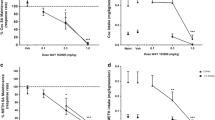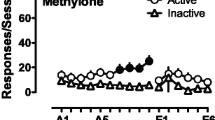Abstract
Rationale
The interoceptive and reinforcing effects of 3,4-methylenedioxymethamphetamine (MDMA) are similar to those of psychostimulants, but the role of dopamine in the behavioral effects of MDMA is not well documented, especially in primates.
Objective
The aim of this study was to assess the role of dopamine in the behavioral effects of MDMA in two nonhuman primate species.
Methods
The behavioral effects of MDMA, with and without serotonergic or dopaminergic pretreatments, were studied in squirrel monkeys trained to respond under a fixed-interval schedule of stimulus termination; effects on caudate dopamine levels were studied in a separate group of squirrel monkeys using in vivo microdialysis. Positron emission tomography neuroimaging with the dopamine transporter (DAT) ligand [18F]FECNT was used to determine DAT occupancy by MDMA in rhesus monkeys.
Results
MDMA (0.5–1.5 mg/kg) did not induce behavioral stimulant effects, but the highest dose of MDMA suppressed responding. Pretreatment with fluoxetine (3.0 mg/kg) or the selective 5HT2A antagonist M100907 (0.03–0.3 mg/kg) attenuated the rate suppressing effects of MDMA. In contrast, pretreatment with the selective dopamine transporter inhibitor RTI-177 (0.1 mg/kg) did not alter the rate suppressing effects of MDMA. Administration of MDMA at a dose that suppressed operant behavior had negligible effects on extracellular dopamine. The percent DAT occupancy of MDMA at a dose that suppressed operant behavior also was marginal and reflected low in vivo potency for DAT binding.
Conclusions
Collectively, these results indicate that behaviorally relevant doses of MDMA do not induce behavioral stimulant or dopamine transporter-mediated effects in nonhuman primates.





Similar content being viewed by others
References
Acquas E, Pisanu A, Spiga S, Plumitallo A, Zernig G, Di Chiara G (2007) Differential effects of intravenous R,S-(+/−)-3,4-methylenedioxymethamphetamine (MDMA, Ecstasy) and its S(+)- and R(−)-enantiomers on dopamine transmission and extracellular signal regulated kinase phosphorylation (pERK) in the rat nucleus accumbens shell and core. J Neurochem 102(1):121–132
Banks ML, Sprague JE, Czoty PW, Nader MA (2008) Effects of ambient temperature on the relative reinforcing strength of MDMA using a choice procedure in monkeys. Psychopharmacology 196(1):63–70
Bankson MG, Cunningham KA (2001) 3, 4-Methylenedioxymethamphetamine (MDMA) as a unique model of serotonin receptor function and serotonin–dopamine interaction. J Pharmacol Exp Ther 297:846–852
Bankson MG, Cunningham KA (2002) Pharmacological studies of the acute effects of (+)-3, 4-methylenedioxymethamphetamine on locomotor activity: role of 5-HT1b/1d and 5-HT2 receptors. Neuropsychopharmacology 26:40–52
Baumann MH, Clark RD, Budzynski AG, Partilla JS, Blough BE, Rothman RB (2004) Effects of “Legal X” piperazine analogs on dopamine and serotonin release in rat brain. Ann N Y Acad Sci 1025:189–197
Baumann MH, Clark RD, Rothman RB (2008) Locomotor stimulation produced by 3, 4-methylenedioxymethamphetamine (MDMA) is correlated with dialysate levels of serotonin and dopamine in rat brain. Pharmacol Biochem Behav 90(2):208–217
Beardsley PM, Balster RL, Harris LS (1986) Self-administration of methylenedioxymethamphetamine (MDMA) by rhesus monkeys. Drug Alcohol Depend 18(2):149–157
Bubar MJ, Pack KM, Frankel PS, Cunningham KA (2004) Effects of dopamine D1- or D2-like receptor antagonists on the hypermotive and discriminative stimulus effects of (+)-MDMA. Psychopharmacology 173(3–4):326–336
Crean RD, Davis SA, Von Huben SN, Lay CC, Katner SN, Taffe MA (2006) Effects of (+/−) 3, 4-methylenedioxymethamphetamine, (+/−) 3, 4-methylenedioxyamphetamine and methamphetamine on temperature and activity in rhesus macaques. Neuroscience 142(2):515–525
Czoty PW, Justice JB Jr, Howell LL (2000) Cocaine-induced changes in extracellular dopamine determined by microdialysis in awake squirrel monkeys. Psychopharmacology 148(3):299–306
Czoty PW, Ginsburg BC, Howell LL (2002) Serotonergic attenuation of the reinforcing and neurochemical effects of cocaine in squirrel monkeys. J Pharmacol Exp Ther 300(3):831–837
Czoty PW, Makriyannis A, Bergman J (2004) Methamphetamine discrimination and in vivo microdialysis in squirrel monkeys. Psychopharmacology 175(2):170–178
Daniela E, Brennan K, Gittings D, Hely L, Schenk S (2004) Effect of SCH 23390 on (+/−)-3, 4-methylenedioxymethamphetamine hyperactivity and self-administration in rats. Pharmacol Biochem Behav 77(4):745–750
Fantegrossi WE, Ullrich T, Rice KC, Woods JH, Winger G (2002) 3, 4-Methylenedioxy-methamphetamine (MDMA, “Ecstasy”) and its stereoisomers as reinforcers in rhesus monkeys: serotonergic involvement. Psychopharmacology 161:356–364
Fantegrossi WE, Woolverton WL, Kilbourn M, Sherman P, Yuan J, Hatzidimitriou G, Ricaurte GA, Woods JH, Winger G (2004) Behavioral and neurochemical consequences of long-term intravenous self-administration of MDMA and its enantiomers by rhesus monkeys. Neuropsychopharmacology 29(7):1270–1281
Fischer C, Hatzidimitriou G, Wlos J, Katz J, Ricaurte G (1995) Reorganization of ascending 5-HT axon projections in animals previously exposed to the recreational drug (+/−) 3, 4-methylenedioxymethamphetamine (MDMA, “ecstasy”). J Neurosci 15(8):5476–5485
Frederick DL, Ali SF, Slikker W Jr, Gillam MP, Allen RR, Paule MG (1995) Behavioral and neurochemical effects of chronic methylenedioxymethamphetamine (MDMA) treatment in rhesus monkeys. Neurotoxicol Teratol 17(5):531–543
Ginsburg BC, Kimmel HL, Carroll FI, Goodman MM, Howell LL (2005) Interaction of cocaine and dopamine transporter inhibitors on behavior and neurochemistry in monkeys. Pharmacol Biochem Behav 80(3):481–491
Goodman MM, Kilts CD, Keil R, Shi B, Martarello L, Xing D, Votaw J, Ely TD, Lambert P, Owens MJ, Camp VM, Malveaux E, Hoffman JM (2000) 18F-labeled FECNT: a selective radioligand for PET imaging of brain dopamine transporters. Nucl Med Biol 27(1):1–12
Gudelsky GA, Yamamoto BK (2008) Actions of 3, 4-methylenedioxymethamphetamine (MDMA) on cerebral dopaminergic, serotonergic and cholinergic neurons. Pharmacol Biochem Behav 90(2):198–207
Howell LL, Byrd LD (1995) Serotonergic modulation of the behavioral effects of cocaine in the squirrel monkey. J Pharmacol Exp Ther 275(3):1551–1559
Howell LL, Czoty PW, Byrd LD (1997) Pharmacological interactions between serotonin and dopamine on behavior in the squirrel monkey. Psychopharmacology 131(1):40–48
Iravani MM, Asari D, Patel J, Wieczorek WJ, Kruk ZL (2000) Direct effects of 3, 4-methylenedioxymethamphetamine (MDMA) on serotonin or dopamine release and uptake in the caudate putamen, nucleus accumbens, substantia nigra pars reticulata, and the dorsal raphe nucleus slices. Synapse 36:275–285
Johanson CE, Kilbey M, Gatchalian K, Tancer M (2006) Discriminative stimulus effects of 3, 4-methylenedioxymethamphetamine (MDMA) in humans trained to discriminate among d-amphetamine, meta-chlorophenylpiperazine and placebo. Drug Alcohol Depend 81(1):27–36
Kamien JB, Johanson CE, Schuster CR, Woolverton WL (1986) The effects of (+/−)-methylenedioxymethamphetamine and (+/−)-methylenedioxyamphetamine in monkeys trained to discriminate (+)-amphetamine from saline. Drug Alcohol Depend 18(2):139–147
Katz JL, Alling K, Shores E, Witkin JM (1995) Effects of D1 dopamine agonists on schedule-controlled behavior in the squirrel monkey. Behav Pharmacol 6(2):143–148
Kimmel HL, O'Connor JA, Carroll FI, Howell LL (2007) Faster onset and dopamine transporter selectivity predict stimulant and reinforcing effects of cocaine analogs in squirrel monkeys. Pharmacol Biochem Behav 86(1):45–54
Lamb RJ, Griffiths RR (1987) Self-injection of d, 1-3, 4-methylenedioxymethamphetamine (MDMA) in the baboon. Psychopharmacology 91(3):268–272
Lile JA, Ross JT, Nader MA (2005) A comparison of the reinforcing efficacy of 3, 4-methylenedioxymethamphetamine (MDMA, “ecstasy”) with cocaine in rhesus monkeys. Drug Alcohol Depend 78(2):135–140
Lindsey KP, Wilcox KM, Votaw JR, Goodman MM, Plisson C, Carroll FI, Rice KC, Howell LL (2004) Effects of dopamine transporter inhibitors on cocaine self-administration in rhesus monkeys: relationship to transporter occupancy determined by positron emission tomography neuroimaging. J Pharmacol Exp Ther 309(3):959–969
Nash JF, Brodkin J (1991) Microdialysis studies on 3, 4-methylenedioxymehtamphetmine-induced dopamine release: effect of dopamine uptake inhibitors. J Pharmacol Exp Ther 259:820–825
Peroutka SJ, Newman H, Harris H (1988) Subjective effects of 3,4-methylenedioxymethamphetamine in recreational users. Neuropsychopharmacology 1(4):273–277
Risbrough VB, Masten VL, Caldwell S, Paulus MP, Low MJ, Geyer MA (2006) Differential contributions of dopamine D1, D2, and D3 receptors to MDMA-induced effects on locomotor behavior patterns in mice. Neuropsychopharmacology 31(11):2349–2358
Ritz MC, Kuhar MJ (1989) Relationship between self-administration of amphetamine and monoamine receptors in brain: comparison with cocaine. J Pharmacol Exp Ther 248(3):1010–1017
Setola V, Hufeisen SJ, Grande-Allen KJ, Vesely I, Glennon RA, Blough B, Rothman RB, Roth BL (2003) 3, 4-Methylenedioxymethamphetamine (MDMA, “Ecstasy”) induces fenfluramine-like proliferative actions on human cardiac valvular interstitial cells in vitro. Mol Pharmacol 63(6):1223–1229
Slikker W Jr, Ali SF, Scallet AC, Frith CH, Newport GD, Bailey JR (1988) Neurochemical and neurohistological alterations in the rat and monkey produced by orally administered methylenedioxymethamphetamine (MDMA). Toxicol Appl Pharmacol 94(3):448–457
Slikker W Jr, Holson RR, Ali SF, Kolta MG, Paule MG, Scallet AC, McMillan DE, Bailey JR, Hong JS, Scalzo FM (1989) Behavioral and neurochemical effects of orally administered MDMA in the rodent and nonhuman primate. Neurotoxicology 10:529–542
Taffe MA, Lay CC, Von Huben SN, Davis SA, Crean RD, Katner SN (2006) Hyperthermia induced by 3, 4-methylenedioxymethamphetamine in unrestrained rhesus monkeys. Drug Alcohol Depend 82(3):276–281
Tancer ME, Johanson CE (2001) The subjective effects of MDMA and mCPP in moderate users. Drug Alcohol Depend 65(1):97–101
Tancer M, Johanson CE (2003) Reinforcing, subjective, and physiological effects of MDMA in humans: a comparison with d-amphetamine and mCPP. Drug Alcohol Depend 72(1):33–44
Tancer M, Johanson CE (2007) The effects of fluoxetine on the subjective and physiological effects of 3,4-methylenedioxymethamphetamine (MDMA) in humans. Psychopharmacology 189(4):565–573
Vollenweider FX, Remensberger S, Hell D, Geyer MA (1999) Opposite effects of 3, 4-methylenedioxymethamphetamine (MDMA) on sensorimotor gating in rats versus healthy humans. Psychopharmacology 143(4):365–372
Votaw JR, Howell LL, Martarello L, Hoffman JM, Kilts CD, Lindsey KP, Goodman MM (2002) Measurement of dopamine transporter occupancy for multiple injections of cocaine using a single injection of [F-18]FECNT. Synapse 44(4):203–210
Wang Z, Woolverton WL (2007) Estimating the relative reinforcing strength of (±)-3, 4-methylenedioxymethamphetamine (MDMA) and its isomers in rhesus monkeys: comparison to (+)-methamphetamine. Psychopharmacology 189:483–488
White SR, Obradovic T, Imel KM, Wheaton MJ (1996) The effects of methylenedioxymethamphetamine (MDMA, ‘ecstasy’) on monoaminergic neurotransmission in the central nervous system. Prog Neurobiol 49:455–479
Wilcox KM, Lindsey KP, Votaw JR, Goodman MM, Martarello L, Carroll FI, Howell LL (2002) Self-administration of cocaine and the cocaine analog RTI-113: relationship to dopamine transporter occupancy determined by PET neuroimaging in rhesus monkeys. Synapse 43(1):78–85
Yamamoto BK, Spanos LJ (1988) The acute effects of methylenedioxymethamphetamine on dopamine release in the awake-behaving rat. Eur J Pharmacol 148:195–203
Acknowledgments
Expert technical assistance with all nonhuman primate procedures was provided by Tango Howard, Carol Nichols, Jodi Godfrey, and Lisa Neidert at the Yerkes National Primate Research Center. The authors express their gratitude to Larry Williams at the Emory University PET Center for his skilled aid in the conduct of the imaging procedures. These studies were supported by USPHS Grants DA10344 (LLH), DA12514 (LLH), DA00517 (LLH), DA20645 (WEF), RR00165 (LLH and WEF), and RR020146 (WEF).
Author information
Authors and Affiliations
Corresponding author
Rights and permissions
About this article
Cite this article
Fantegrossi, W.E., Bauzo, R.M., Manvich, D.M. et al. Role of dopamine transporters in the behavioral effects of 3,4-methylenedioxymethamphetamine (MDMA) in nonhuman primates. Psychopharmacology 205, 337–347 (2009). https://doi.org/10.1007/s00213-009-1545-0
Received:
Accepted:
Published:
Issue Date:
DOI: https://doi.org/10.1007/s00213-009-1545-0




